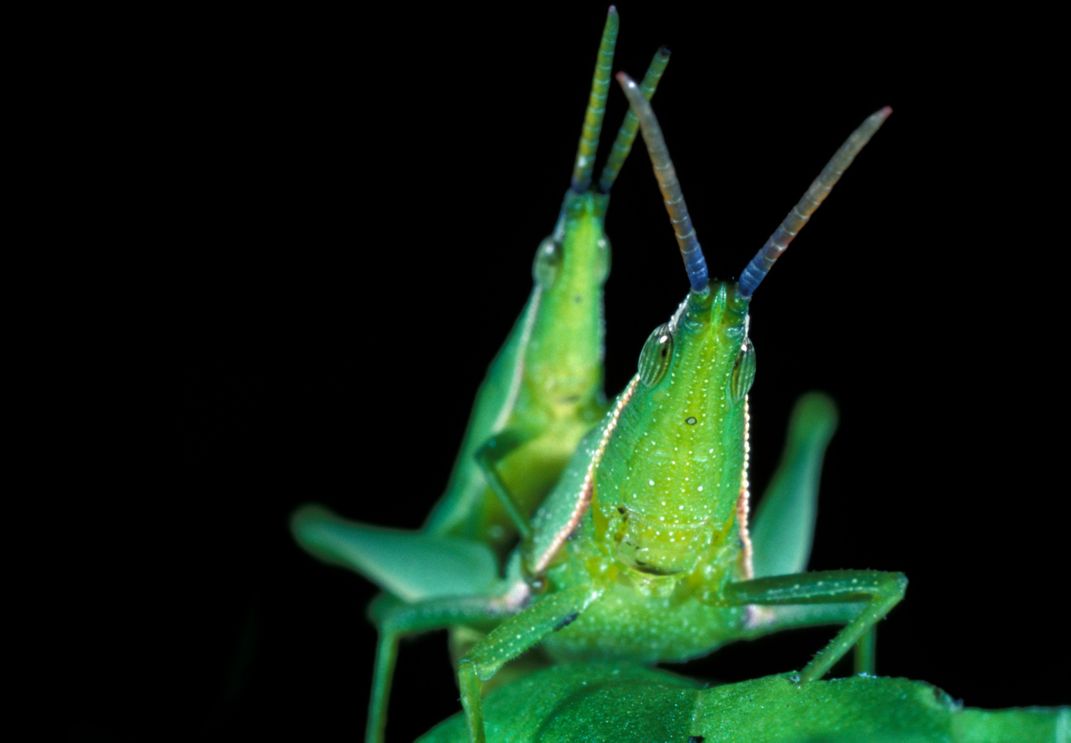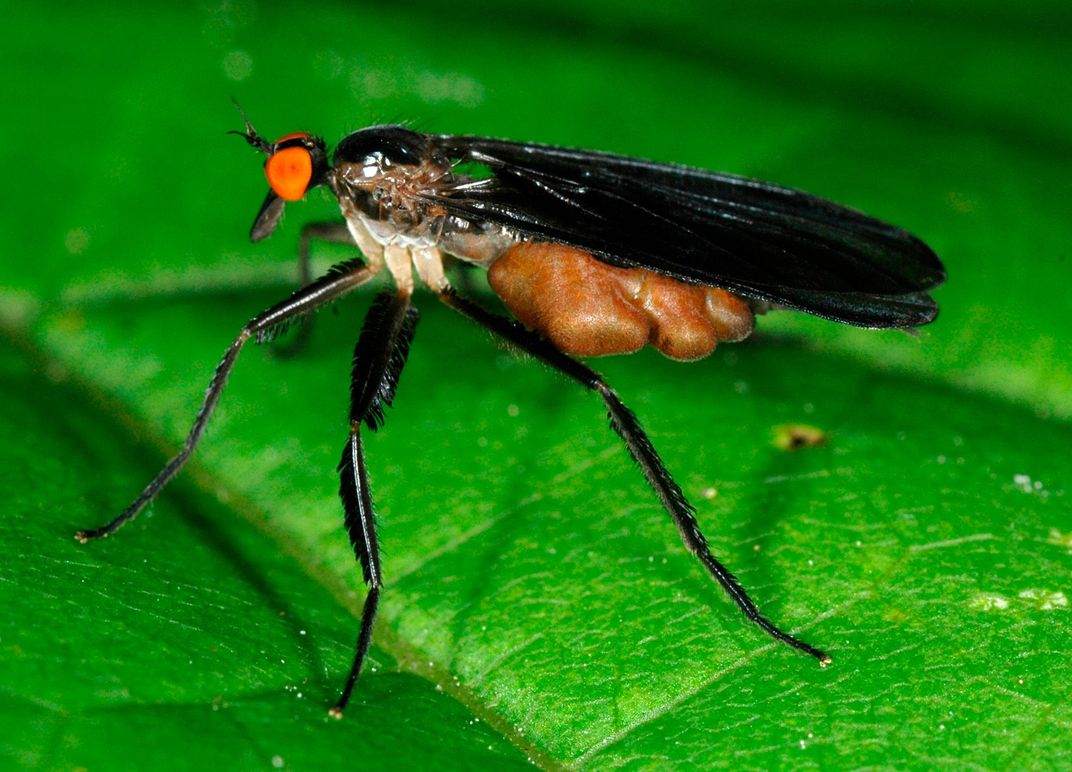Why Snail Sex Is Like a Box of Chocolates
To up the romance factor, some animals pair amorous advances with tasty gifts
/https://tf-cmsv2-smithsonianmag-media.s3.amazonaws.com/filer/15/bf/15bf2e71-416c-4bfc-929a-a69e4d9253b7/istock-185090020.jpg)
When you kneel down to give your sweetie an engagement ring, you’re taking part in a time-honored western ritual: sealing a partnership with gifts. In other parts of the planet, nuptial gifts can mean the bride’s family gives a dowry; in some cultures, mutual dowries are exchanged. But humans aren't the only ones who have found that romance often works better when it comes with presents.
Scientists have found that some of the creepiest, crawliest creatures on the planet also take part in amorous gift-giving. Male dance flies, katydids and certain spiders offer a free meal to the objects of their affection; snails include a shot of fortifying nutrients with their sperm. Apart from convincing prospective mates to share a romantic moment, such offerings can strengthen the female after mating and sometimes even lessen her likelihood to mate with others.
When it comes to non-human animals, though, it might help to think of more edible gifts than metal rings. “It’s like giving her a box of chocolates,” says Joris Koene, an assistant professor in biology at Vrije Universiteit Amsterdam who studies snail reproduction. Koene says the term in wildlife usually applies to species with separate male and female sexes, which contribute a gift of energy or specific substances that the female can then invest in her eggs.
Now researchers are starting to untangle why species that fall outside of heteronormative partnerships have developed different gift-giving traditions—or none at all.
Koene recently co-authored a study on snails that sought to understand the kind of nutrient exchange that occurs when species mate outside of the male-female dichotomy. To figure out what kind of resource exchange was going on, Koene and his coauthors monitored the amount of nutrients like carbon and nitrogen transferred between two different species of hermaphroditic snails.
The species he focused on were the fresh water Lymnaea stagnalis, or the great pond snail, and the land snail known as Cornu aspersum. The pond snail is a hermaphrodite that can choose the role of giver or taker in a relationship. By contrast, for the land snail to successfully mate, both mollusks have to insert their reproductive organs into each other at the same time. “The penises have to be inserted into each other in order to mate. Otherwise nothing happens,” Koene explains.

This behavior made Koene and his colleagues wonder whether the nuptial gift concept even applied in this case. After all, if both sides exchange gifts along with their sperm, isn’t it a zero-sum game? To find out, researchers watched the land snails have sex, then callously pulled them apart past the point of no return, but just before each of them had ejaculated. They then collected the resulting substance that the snails excreted.
Analyzing the contents, they found that the snails did indeed exchange some nutrients. But the mutual ejaculation erased any benefit that either individual might have received from the exchange. In fact, when accounting for the energy expended in the exchange, both individuals end up losing out in a strict economy of energy because of the effort spent getting busy.
In the case of the land snails, researchers didn’t have to hurt or kill the animals in order to better understand their behavior. “We just traumatize them a little bit,” Koene says, adding that it was for all “for the sake of science.” But the great pond snails weren’t quite so lucky, since they don’t prepare their ejaculate before transfer; Koene says they had to kill the animals in order to collect the substance.
While they found that the latter snails likely do contribute some nutrients to their partners, it wasn't nearly enough to actually help in the production of eggs. “You would need about 20 or 30 ejaculates to have a proper contribution to one egg clutch,” Koene says. “For both of the [snail species] we tested, if you add things up it doesn’t really benefit them that much.”
In that way, the ejaculated nutrients really are like a box of chocolates: they may provide a nice momentary boost, but they don’t actually help with child-rearing.
Karim Vahed, a professor of entomology at the University of Derby in England who has published several papers on nuptial gifts, says that the new research shows how the concept of nuptial gift exchange is much more complicated when we account for the fact that some species don’t necessarily operate under a binary male-female relationship.
“It’s the first paper that I’m aware of that actually drills down into that question more deeply by actually looking at what quantity of substances is exchanged,” he says.
Vahed adds that the snail situation stands in contrast to the huge nuptial gifts that some insects donate to their partners. Male katydids, for example, produce a spermatophore during mating that can be up to 30 percent of their body mass, which contains both ejaculate and a mass of edible jelly. The female eats the jelly while the sperm enters her body, and then consumes any leftover sperm for added sustenance.
By giving a large gift to the female, who isn't monogamous, the male ensures that she will spend some time consuming it. His ejaculate confers another reproductive benefit as well: it contains substances referred to by researchers as "ejaculate allohormones," which actually switch off female sexual receptivity.
“The males could actually be subtly manipulating female behavior by prolonging ejaculate transfers,” Vahed says.

Other species have a hunger for sex—and the nuptial gifts that come with it—that can’t be as easily squelched.
Dance flies in the U.S. Northeast and Canada are peculiar in the animal kingdom in that the females of the species are more ornamental than the males. During dawn and dusk, the females will take wing, sucking in huge quantities of air to inflate their bright orange abdomens. The inflated abdomens swell to disks about the third of a size of a penny, ensuring that the mosquito-sized males will see them silhouetted against the horizon.
“They’re like little insect peacock tails,” says Darryl Gwynne, a biology professor at the University of Toronto Mississauga. “When they really get going, there will be thousands of them.” And like male peacocks, these insects sacrifice physical fitness for sex appeal: Their ornamented, scaled legs and puffy bodies makes them clumsy, so they are more likely to blunder into spider webs than the males of the species.
Yet these females' seemingly counterproductive behavior is motivated by a powerful, instinctive urge: the munchies. The flies that males catch and present to potential mates, it turns out, comprise the female’s only source of sustenance. So in this case, attractive accoutrements aren’t only a matter of passing on one’s genes. It’s also about immediate survival. “With the [female] dance flies, it’s hunger that drives them,” he says.
Hungry female dance flies will mate with as many males as they can. This satisfies their appetite, as well as ensures a healthy genetic mix among their offspring. But Luc Bussiere, an evolutionary biology professor at the University of Stirling in Scotland who has worked with Gwynne on dance flies, says it’s in the best interests of the males to mate with a female who isn’t as flashy. That way, he’s more likely to be her one and only.
Or so one might think. Having a large abdomen, says Bussiere, might indicate to a male that a female is in peak mating form. “You can understand why males would like to mate with really fat females,” he says. “First of all she’s probably got more eggs. And more importantly, those eggs are probably nearly ready to be laid.” But seemingly large and fertile females may actually be a trick of the eye, deceiving males with their inflated, shiny bodies.
Male gift-givers can be tricksters, too. Nursery web spiders catch insects for their female consorts in an effort to woo them and avoid getting eaten themselves. But males who aren’t as good as hunting down bugs will often give the female a fake meal instead. “In some cases the males actually cheat by transferring something inedible,” Bussiere says. The fact that they wrap it in webbing allows them to hide inedible items in a silk package.
Bussiere says that Koene's work helps reveal the biases that human researchers exhibit when studying animals that don’t have separate sexes or operate in monogamous male-female partnerships. Blow-up flies, fake rings, and nutrient packages that cancel each other out all serve to illustrate the number of twists and turns that exist in nuptial gift giving across species.
“The male reproductive strategy of giving nuptial gifts cannot be generalized to any sexually reproducing animal,” says Monica Lodi, the lead author of the recent study with Koene. “If we don’t step outside that general habit, we draw incorrect conclusions about the prevalence of these behaviors or these ways of life.” Romance, it seems, comes in many forms.
/https://tf-cmsv2-smithsonianmag-media.s3.amazonaws.com/accounts/headshot/joshua-learn_copy.jpg)
/https://tf-cmsv2-smithsonianmag-media.s3.amazonaws.com/accounts/headshot/joshua-learn_copy.jpg)